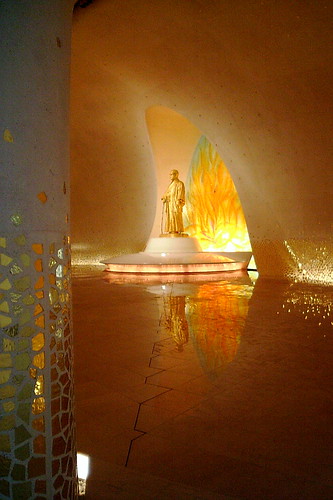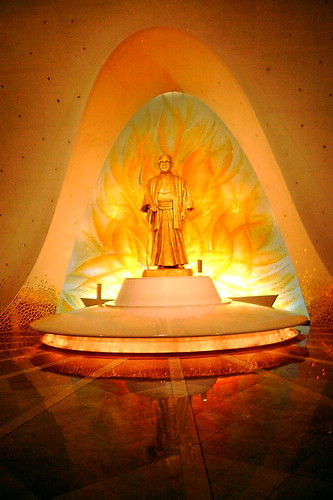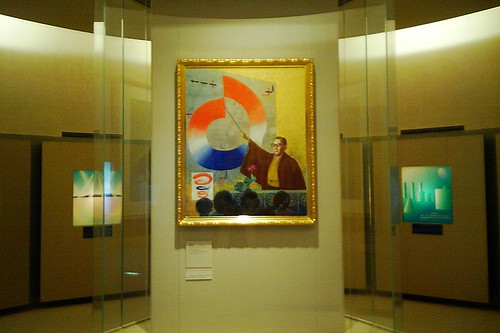More Mahikari Madness
Today was a good day.
Before taking off for Kanazawa this coming Tuesday to avail ourselves of the cultural offerings on tap there, today we decided to sample some of the local fare. Specifically, a bit more of our neighborhood apocalyptic cult and international marching band known as Sukyo Mahikari. For a little history of the group, check my earlier post.
Takayama is not really the cult's "company town", but they've got an awful lot of buildings around here. Besides the "World Shrine of Sukyo Mahikari" and the "Sukyo Mahikari Headquarters", there's also the "Hikaru Memorial Museum", which is what we decided to visit today.

The first thing you notice is the structure itself. The museum, according to the supplied brochure, is constructed to resemble a temple complex from ancient Mesoamerica... yeah, by way of Logan's Run. Why is it that the future, the hidden machinery of god and pastel new-ageism always seems to meet back up in the 70's?

Granted, when you first see it it's an impressive sight. But, and I think this matters, it's sited in a rural mountain valley in Japan. Then again, that would be in keeping with the syncretic nature of the Mahikari religion, which seems to be a mix of Christianity, Buddhism, Confucianism, and Japanese folk tradition. However, according to the museum's brochure, in an attempt "to harmonize with the natural environs, the greater part of the museum was constructed underground", which seems to implicitly acknowledge it's disjunctive nature. Also, building something underground is fine in theory (and with adequate ventilation) but the result is that the place smells a bit like your best friend's basement rec room.
Actually, the interior of the place is well designed and architecturally impressive, in a kind of Hyatt-Disney-Dianetics kind of fashion. And the stated focus of the museum is very earnest. The 2 main halls are the "Hida Hall", which explores the geological history of the Hida region through fossils and plaster dinosaurs; and the "World History Hall", which showcases the Mesopotamian, Greek, Chinese, Indus Valley, Mesoamerican, Andean and ancient Japanese cultures in an effort to "give you an idea of how the desire to worship God manifested itself in the great civilizations of the world throughout the ages".

It's not until you get into the physical and spiritual heart of the place that you get to the real (for me at least) fun of the place, the Kotama Okada Memorial Hall. Mr. Okada is the founder of Mahikari and, apparently, the true saviorvior of mankind.

Here's what I've dubbed "Mr. Okada's Womb Room", an ovoid, sparkly space that's part Roger Dean (think old "Yes" album artwork) and part "Chi-Chi's". Actually, popping off the shots was kinda iffy as photos aren't allowed. And the place doesn't lack for true believers. Right after these photos were taken a family marched in and promptly started bowing to Okada-san's graven image... Afterwards I decided to change the shutter sound on my cellphone to a much less obvious musical chime.
In the rest of the hall various artifacts from Mr. Okada's life are preserved, from a pair of beach flipflops with "O.K." inscribed on them, to a bathroom mural depicting Mt. Fuji that he liked to gaze at, to an old yukata still redolent of the hair pomade he favored (and according to the placard, the scent still capable of curing paralysis).
Other parts of the hall cover different aspect of the religion, from a timeline of it's creation to various aspects of it's philosophy.

Here Okada-san explains how the world works.

Which I guess is kind of like how "Degree" anti-perspirant works.
Seriously, this whole effort seems to be about wrapping some reasonable, unthreatening, scientific-like verneer around what is, on closer approach, potentially a rather stinky proposition. No matter how neutral and innocuous the place may seem, it is in fact, part of the outreach program of an international cult. Which itself is a creepy mix of Christian self-loathing and Asian collectivism. There's something vaguely Kim-Jong Il about the whole place. In fact, as we were pulling into the parking lot, teams of the faithfull were piling out of tour buses so that they could shovel the sidewalks around the museum clear of snow.
They were still at it on our way out.
Before taking off for Kanazawa this coming Tuesday to avail ourselves of the cultural offerings on tap there, today we decided to sample some of the local fare. Specifically, a bit more of our neighborhood apocalyptic cult and international marching band known as Sukyo Mahikari. For a little history of the group, check my earlier post.
Takayama is not really the cult's "company town", but they've got an awful lot of buildings around here. Besides the "World Shrine of Sukyo Mahikari" and the "Sukyo Mahikari Headquarters", there's also the "Hikaru Memorial Museum", which is what we decided to visit today.

The first thing you notice is the structure itself. The museum, according to the supplied brochure, is constructed to resemble a temple complex from ancient Mesoamerica... yeah, by way of Logan's Run. Why is it that the future, the hidden machinery of god and pastel new-ageism always seems to meet back up in the 70's?

Granted, when you first see it it's an impressive sight. But, and I think this matters, it's sited in a rural mountain valley in Japan. Then again, that would be in keeping with the syncretic nature of the Mahikari religion, which seems to be a mix of Christianity, Buddhism, Confucianism, and Japanese folk tradition. However, according to the museum's brochure, in an attempt "to harmonize with the natural environs, the greater part of the museum was constructed underground", which seems to implicitly acknowledge it's disjunctive nature. Also, building something underground is fine in theory (and with adequate ventilation) but the result is that the place smells a bit like your best friend's basement rec room.
Actually, the interior of the place is well designed and architecturally impressive, in a kind of Hyatt-Disney-Dianetics kind of fashion. And the stated focus of the museum is very earnest. The 2 main halls are the "Hida Hall", which explores the geological history of the Hida region through fossils and plaster dinosaurs; and the "World History Hall", which showcases the Mesopotamian, Greek, Chinese, Indus Valley, Mesoamerican, Andean and ancient Japanese cultures in an effort to "give you an idea of how the desire to worship God manifested itself in the great civilizations of the world throughout the ages".

It's not until you get into the physical and spiritual heart of the place that you get to the real (for me at least) fun of the place, the Kotama Okada Memorial Hall. Mr. Okada is the founder of Mahikari and, apparently, the true saviorvior of mankind.

Here's what I've dubbed "Mr. Okada's Womb Room", an ovoid, sparkly space that's part Roger Dean (think old "Yes" album artwork) and part "Chi-Chi's". Actually, popping off the shots was kinda iffy as photos aren't allowed. And the place doesn't lack for true believers. Right after these photos were taken a family marched in and promptly started bowing to Okada-san's graven image... Afterwards I decided to change the shutter sound on my cellphone to a much less obvious musical chime.
In the rest of the hall various artifacts from Mr. Okada's life are preserved, from a pair of beach flipflops with "O.K." inscribed on them, to a bathroom mural depicting Mt. Fuji that he liked to gaze at, to an old yukata still redolent of the hair pomade he favored (and according to the placard, the scent still capable of curing paralysis).
Other parts of the hall cover different aspect of the religion, from a timeline of it's creation to various aspects of it's philosophy.

Here Okada-san explains how the world works.
Which I guess is kind of like how "Degree" anti-perspirant works.
Seriously, this whole effort seems to be about wrapping some reasonable, unthreatening, scientific-like verneer around what is, on closer approach, potentially a rather stinky proposition. No matter how neutral and innocuous the place may seem, it is in fact, part of the outreach program of an international cult. Which itself is a creepy mix of Christian self-loathing and Asian collectivism. There's something vaguely Kim-Jong Il about the whole place. In fact, as we were pulling into the parking lot, teams of the faithfull were piling out of tour buses so that they could shovel the sidewalks around the museum clear of snow.
They were still at it on our way out.
Tags:





